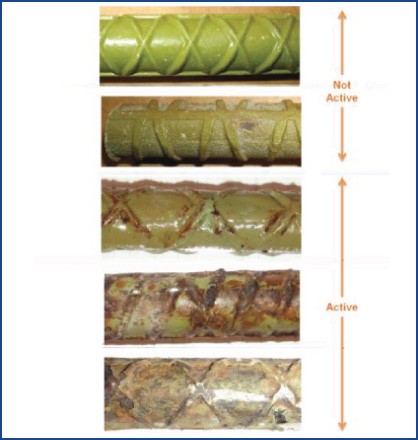
Transportation agencies and others funding the construction of major infrastructure need assurance that their service life requirements will be met during the design and construction phases of such projects. Probabilistic service life modeling of chloride-induced corrosion should consider the statistical distributions of key parameters that influence corrosion initiation and subsequent damage. For typical reinforced concrete structures (such as bridge decks), these are chloride exposure, chloride penetration resistance of the concrete, chloride-induced corrosion threshold, depth of concrete cover, and corrosion propagation time.
In this article, engineers John Lawler, Stephen Garrett, Paul Krauss, and Jonah Kurth (Structural Technologies) discuss how projections of the service life of concrete structures subject to such exposure may be achieved through modeling of chloride transport through the cover concrete and eventual corrosion initiation and propagation. This article also provides recommendations for statistical distributions for the chloride threshold to be used in service life modeling for structures containing carbon steel and epoxy-coated reinforcing bars (ECR).
This article was originally published in the March/April 2021 issue of ACI Materials Journal—the peer-reviewed publication the American Concrete Institute (ACI) has proudly shared with their members since 1904. Learn more about the journal.
RELATED INFORMATION
-
 John S. Lawler, PrincipalWJE Northbrook MORE >People | John S. Lawler, Principal
John S. Lawler, PrincipalWJE Northbrook MORE >People | John S. Lawler, Principal -
 Paul Krauss, PrincipalWJE Northbrook MORE >People | Paul Krauss, Principal
Paul Krauss, PrincipalWJE Northbrook MORE >People | Paul Krauss, Principal -
 Stephen M. Garrett, Senior AssociateWJE Northbrook MORE >People | Stephen M. Garrett, Senior Associate
Stephen M. Garrett, Senior AssociateWJE Northbrook MORE >People | Stephen M. Garrett, Senior Associate -
 WJE's Janney Technical Center (JTC) provides advanced testing and forensic capabilities to... MORE >Labs | Janney Technical Center
WJE's Janney Technical Center (JTC) provides advanced testing and forensic capabilities to... MORE >Labs | Janney Technical Center



































